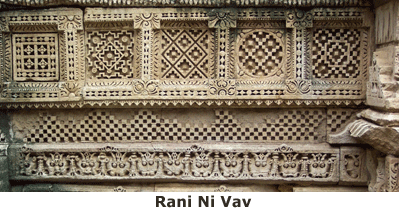Rani Ni Vav................................................................................................................................................................................................................................................................................... Step-wells, subterranean structures with steps leading down to the water level, are found in large numbers in the arid regions of Gujarat and Rajasthan . They started as simple structures, and in course of time, evolved to become complex, aesthetically pleasing works of art. The Rani-Ni-Vav at Patan, is one such monument. The 'Vav' was built during the reign of Rani Udaymati of the Solanki Dynasty, probably as a memorial for her husband Bhimdeva I (1022-1063 AD), it is about 134 kms northwest of Ahmedabad , and about 57 kms from Mehsana. No other 'Vav' or step well in India is so profusely adorned as the Rani-Ni-Vav. More than 800 sculptures form a remarkable backdrop to what was purely a functional structure.
THE ARCHITECTURAL DELIGHT The Rani-Ni-Vav forms the link between a 'kunda' and the now classical step-well. This is due to the fact that in addition to the straight staircase, it also has lateral staircases, along with very broad, stepped corridors. The 'Vav' is laid out in an east-west direction, with the entrance in the east and the well in the west. Though it is in a dilapidated condition, the entrance, the side-walls of the stepped corridor, some of the 'mandapas' and the back wall of the well are still intact. Five lateral, staggered staircases attached to be side-walls connect various storeys. SCULPTURES OF DEITIES The 'Vav' is very rich in sculptures. Each level is profusely adorned with carved friezes and deities. Sculptures of deities in recessed and projecting niches cover all sides of the well. The lower most level has 37 niches with rudimentary images of Lord Ganesh in the centre. The images of Sheshashayi Vishnu in the central niches, on the upper levels, are more elaborate. Also, on the upper levels, are impressive images of Laxmi-Narayana, Uma-Mahesh, Brahma-Brahmi, and Kuber and Ganesh, with their respective consorts. On the lower levels, are the images of Vishnu's incarnations and 24 forms. Interestingly, however, despite the fact that the 'Vav' is a water structure, the 'Kurma' and the 'Matsya' incarnations do not find a place. |
|||||||
|
|
|||||||




